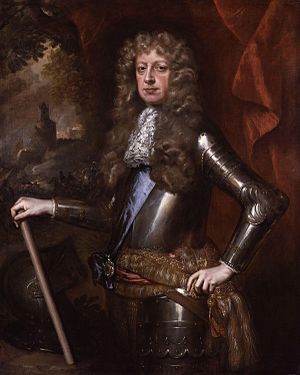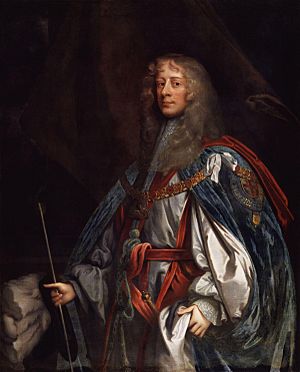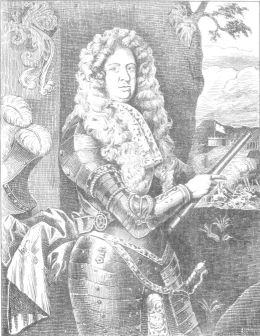James Butler, 1st Duke of Ormonde facts for kids
Quick facts for kids
The Duke of Ormonde
|
|
|---|---|

The Duke of Ormonde, by William Wissing (c. 1680–1685).
|
|
| Personal details | |
| Born | 19 October 1610 Clerkenwell, London, England |
| Died | 21 July 1688 (aged 77) Kingston Lacy, Dorset, England |
| Resting place | Westminster Abbey |
| Occupation | Anglo-Irish politician and soldier |
James Butler, 1st Duke of Ormonde (born October 19, 1610 – died July 21, 1688) was an important Anglo-Irish (meaning he had both English and Irish family roots) politician and soldier. He was a member of the Privy Council, which was a group of trusted advisors to the King.
From 1641 to 1647, he led the fight against the Irish Catholic Confederation. Later, from 1649 to 1650, he was the main commander of the Royalist forces. These forces were fighting against Oliver Cromwell, who wanted to take control of Ireland.
In the 1650s, Ormonde lived in exile (meaning he had to leave his home country) in Europe with Charles II of England. When Charles II was put back on the British throne in 1660, during a time called the Restoration, Ormonde became a very important person in both English and Irish politics.
Contents
Early Life and Family
The Butlers of Ormonde were a powerful family in Ireland. They were known as "Old English" because their ancestors had come from England a long time ago. They had been very important in the southeast of Ireland since the Middle Ages.
James Butler's father was Thomas Butler, Viscount Thurles. Thurles is a place in County Tipperary, Ireland. James was the oldest son in his family.
His father died in 1619 when James was only 9 years old. After his father's death, James became Viscount Thurles. His mother took him to England. There, his grandfather, Walter Butler, 11th Earl of Ormond, sent him to a Catholic school.
However, King James I was the King at that time. He was a Protestant. The King wanted to make sure that James Butler would also be a Protestant. This was because being Protestant would give James more power in Ireland when he returned. So, King James I placed James Butler under the care of archbishop George Abbot. When James was fifteen, he went to live with his grandfather in London.
It became very important in James's life that he was a Protestant. Almost all of his relatives were Catholics. This caused some problems, and his family members often faced difficulties. They had their land and possessions taken from them, and they were not treated fairly because they were Catholics. But this did not happen to James because he was Protestant.
In December 1629, James married Lady Elizabeth Preston. In 1634, when his grandfather died, James became the Earl of Ormonde.
Rebellion and Civil War in Ireland
In 1633, Thomas Wentworth, 1st Earl of Strafford, became the head of government in Ireland. He liked Ormonde and wrote to King Charles I, saying that Ormonde was "young, but take it from me, a very staid head" (meaning he was young but very sensible). Ormonde became Wentworth's friend and supported him.
Wentworth had a plan to take land from Catholics in Ireland. He did this to get money for the British king. He also wanted to reduce the political power of the Irish Catholic gentry (wealthy landowners). Ormonde supported this plan.
These plans made many of Ormonde's relatives very angry. Many of them opposed Wentworth. This led to an armed rebellion. The opposition to Wentworth also helped the English Parliament to start an impeachment (a process to remove a public official from office) against him. Wentworth was executed in May 1641.
When the Irish Rebellion of 1641 began, Ormonde was in charge of the government troops in Dublin. Most of the country was taken over by the Catholic rebels. These rebels even included some of Ormonde's own Butler relatives. A rebel leader named Richard Butler, 3rd Viscount Mountgarret, was Ormonde's cousin. In the spring of 1642, Mountgarret and Ormonde led their opposing sides in the battle of Kilrush. Ormonde's side won that battle.
In the spring of 1642, the Irish Catholics formed their own government, called the Catholic Confederation. Their capital city was Kilkenny. They started to organize their own army. Also, in early 1642, the king sent troops from England and Scotland to help fight. This was the beginning of the Irish Confederate War.
Ormonde successfully cleared the area around Dublin of Confederate forces. He gained control of the area historically known as the Pale, which was a small part of Ireland controlled by the English. In March 1643, Ormonde led his troops to New Ross, which was deep in the Catholic Confederation's territory. He won a small victory there (Battle of New Ross) before returning to Dublin.
However, Ormonde was in a very difficult situation. The Confederates controlled two-thirds of Ireland. The English Civil War had started in September 1642. This meant that no more troops would be sent from England to help him. The King had even asked for the troops he had sent before to be returned to England.
Because he was isolated in Dublin, Ormonde agreed to a ceasefire (a temporary stop to fighting) with the Catholics. This ceasefire began in September 1643. Most of Ireland was given over to the Catholic Confederation. Only areas in the north, the Dublin Pale, around Cork City, and a few small military bases remained under Protestant control. This truce was strongly opposed by the Protestant leaders and people in Ireland.
In November 1643, the king appointed Ormonde as Lord Lieutenant of Ireland. This was the highest position in the Irish government. Ormonde was told to stop the king's enemies in Parliament from getting help from Ireland. He also had to send more troops to fight for the Royalist side in England. He was also given the king's permission to make peace with the Catholic Confederation. If they made peace, the Catholic troops could then fight against the Parliamentarians.
Working with the Irish Catholics
Ormonde had a very difficult job to do.
The native Irish and Catholic Irish of English descent (the "Old English") had their own government in Confederate Ireland. They said they would support King Charles I of England if he would allow them to practice their Catholic religion freely and give them self-government (the right to govern themselves). But, any deals Ormonde made with the Catholic Confederates would make his support among English and Scottish Protestants in Ireland weaker.
On August 25, 1645, Edward Somerset, 2nd Marquess of Worcester, who was acting for King Charles, signed a treaty (a peace agreement) in Kilkenny with the Irish Catholic Confederates. He did not discuss this with the Irish Protestant community. Irish Protestants were strongly against this treaty. So, King Charles was forced to cancel the treaty almost immediately. He was afraid that almost all Irish Protestants would start supporting the other side in the English Civil War.
On March 28, 1646, Ormonde, on behalf of the king, signed another treaty with the Confederates. This treaty gave them religious and other rights. However, the Confederates' General Assembly (their government) in Kilkenny did not like the deal. This was partly because of what the pope's ambassador (nuncio) Giovanni Battista Rinuccini said. He did not want the Catholics to compromise. The Confederates then arrested those among them who had signed the treaty with Ormonde.
Ormonde then realized that he could not stop the Confederates from taking Dublin. He asked for help from the English Long Parliament and signed an agreement with them on June 19, 1647. In early August, Ormonde handed over Dublin, along with 3,000 Royalist troops under his command, to the Parliamentarian commander Michael Jones. Jones had arrived from England with 5,000 Parliamentarian troops. Ormonde then sailed to England. He said about his surrender that he "preferred English rebels to Irish ones."
Even though the Royalist and Parliamentarian troops were fighting against each other in the English Civil War, in Ireland, they joined forces against the Catholic Confederates. The combined troops won a major battle against the Confederates soon afterward near Dublin, at the Battle of Dungan's Hill.
Leading the Royalist Alliance
In March 1648, Ormonde joined the queen and the Prince of Wales in Paris. In September, he went back to Ireland. He planned to try and get the Irish Confederates and the Irish Protestants to support the king, especially now that the pope's ambassador had left.
The Irish Confederates were now willing to make a compromise. Their fight against the English Parliamentarian forces was not going well. On January 17, 1649, Ormonde signed a peace agreement with the rebels. This agreement said that they could practice their religion freely.
After Charles I was executed in 1649, Ormonde declared Ireland's support for Charles II. Ormonde was put in command of the Irish Confederates' armies and also the English Royalist troops who had come to Ireland. Almost all of Ireland was under his control before August 1649. However, Ormonde was not able to stop the conquest of Ireland by Oliver Cromwell in 1649-50.
Most of the English and Protestant Royalist troops left Ormonde's side and went to fight for Cromwell in May 1650. The Irish Catholic troops were the only ones left under his command. They did not trust him. Ormonde was forced to leave his command in late 1650. He returned to France later that year. In Cromwell's Act of Settlement 1652, all of Ormonde's lands in Ireland were taken from him.
Ormonde was a great friend to Charles II and the queen mother in Paris. He traveled to Aix and Cologne with Charles when Charles had to leave France. He played an active part in the secret planning of the Restoration, which was the plan to put Charles II back on the throne of England.
Ormonde's Career After Charles II Became King
After Charles II became king, Ormonde received many different important jobs and titles from the king. He was made:
- a commissioner for the treasury and the navy (meaning he helped manage money and the navy)
- Lord Steward of the Household (a high-ranking official in the royal household)
- a Privy Councillor (a trusted advisor to the monarch)
- Lord Lieutenant of Somerset (the king's representative in a county)
- High Steward of Westminster, Kingston, and Bristol (important local positions)
- chancellor of Trinity College, Dublin (the head of the university)
- Baron Butler of Llanthony and Earl of Brecknock in the peerage of England (new noble titles)
- Duke of Ormonde in the Irish peerage (a higher noble title in Ireland)
- Lord High Steward of England for Charles's coronation that year (a special role for the king's crowning ceremony).
He also got back all of his lands in Ireland. On November 4, 1661, he became Lord Lieutenant of Ireland again. He disagreed when Charles II stopped importing cattle from Ireland. In response, Ormonde stopped importing cattle from Scotland.
In March 1669, Ormonde was removed from the government of Ireland. He did not mind too much. He made sure that his sons and other people who supported him stayed in their important jobs. He was chosen as Chancellor of the University of Oxford on August 4, 1669.
In 1670, an adventurer named Thomas Blood tried to kill the duke. Ormonde was attacked by Blood and his helpers while driving up St James's Street on the night of December 6, 1670. He was pulled out of his carriage and taken on horseback along Piccadilly. They wanted to hang him at Tyburn. However, Ormonde managed to escape.
In 1677, the king decided that Ormonde would become the Lord Lieutenant of Ireland once again.
When he arrived in Ireland, he set up a new tax system and reorganized the army. After the Popish Plot (a false story about a Catholic plan to kill the king) in England in 1678, Ormonde immediately took action to reduce the power of Roman Catholics. There were far more Catholics than Protestants in the country (about 15 Catholics for every 1 Protestant). In 1682, he went back to London at the request of the King, whom he supported. The last important thing he did as lord lieutenant was to declare Irish support for James II of England after Charles II died.
Ormonde lived in retirement at Cornbury in Oxfordshire. Ormonde died on July 21, 1688, at Kingston Lacy, Dorset. He was buried in Westminster Abbey on August 1, 1688.
Images for kids
-
The Duke of Ormond by William Wissing (c. 1680–1685)
-
The Duke of Ormond as Knight of the Garter, wearing the mantle, with its cordon and tassels, and the collar. The hat with its white ostrich feathers is in his left hand. Painted by John Michael Wright (c. 1680).
| Political offices | ||
|---|---|---|
| Preceded by The Earl of Leicester |
Lord Lieutenant of Ireland 1643–1646 |
Succeeded by Lord Lisle |
| Preceded by Lord Lisle |
Lord Lieutenant of Ireland 1648–1649 |
Succeeded by Oliver Cromwell |
| Lord Steward 1660–1688 |
Succeeded by The Earl of Devonshire |
|
| Preceded by The Duke of Albemarle |
Lord Lieutenant of Ireland 1662–1668 |
Succeeded by Earl of Ossory |
| Preceded by The Earl of Essex |
Lord Lieutenant of Ireland 1677–1685 |
Succeeded by Lords Justices |
| Preceded by The Duke of Somerset |
Lord Lieutenant of Somerset 1660–1672 |
Succeeded by The Duke of Somerset |
| Preceded by Gilbert Sheldon |
Chancellor of the University of Oxford 1669–1688 |
Succeeded by The 2nd Duke of Ormonde |
| Peerage of England | ||
| New creation | Duke of Ormonde 1682–1688 |
Succeeded by James Butler |
| New creation | Earl of Brecknock 1660–1688 |
|
| Peerage of Ireland | ||
| New creation | Duke of Ormonde 1661–1688 |
Succeeded by James Butler |
| New creation | Marquess of Ormonde 1642–1688 |
|
| Preceded by Walter Butler |
Earl of Ormonde 1634–1688 |
|
| Earl of Ossory (descended by acceleration) 1634–1662 |
Succeeded by Thomas Butler |
|
See also
 In Spanish: James Butler, I duque de Ormonde para niños
In Spanish: James Butler, I duque de Ormonde para niños






